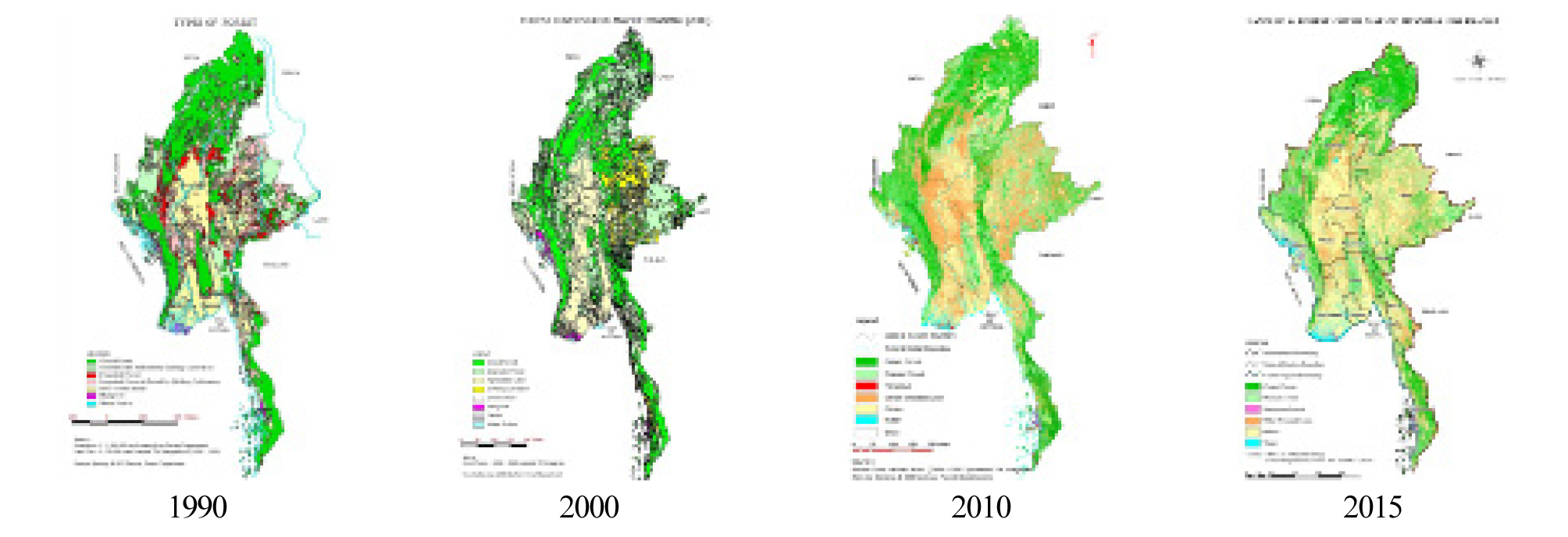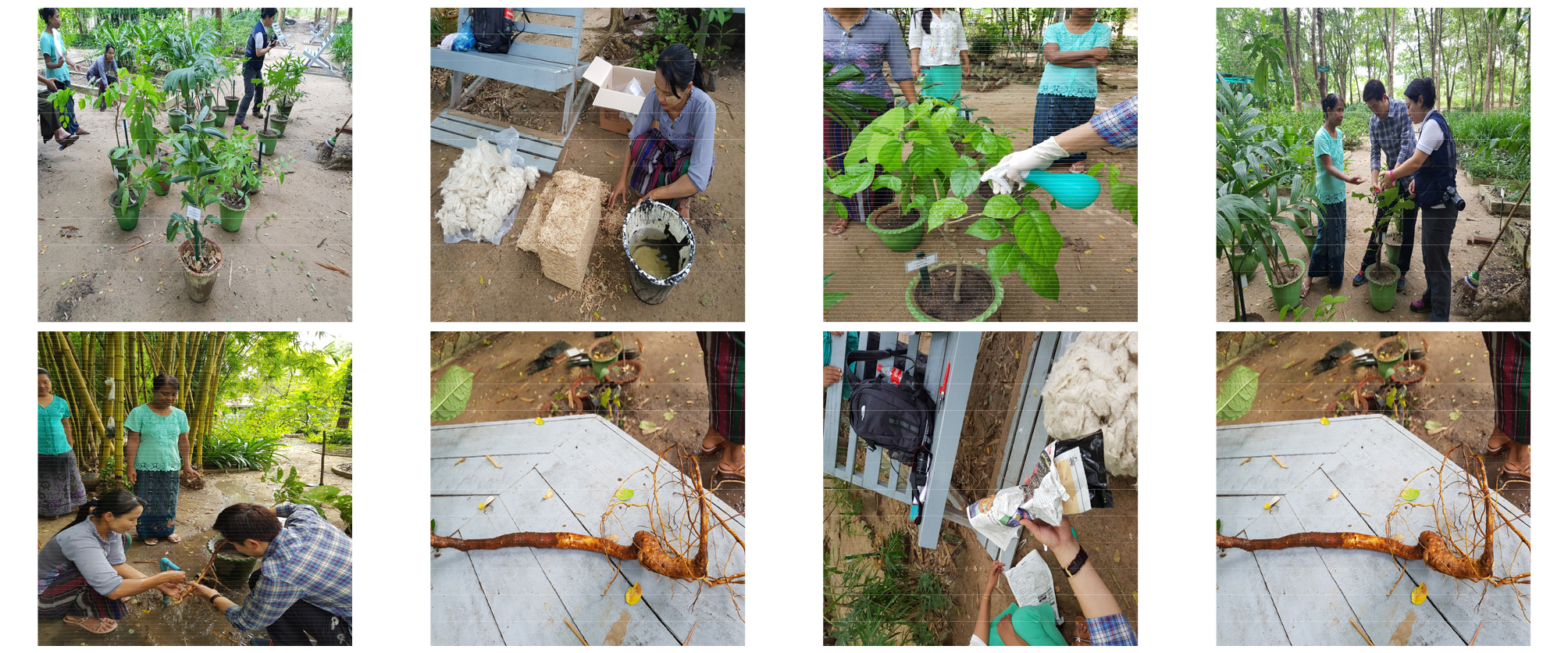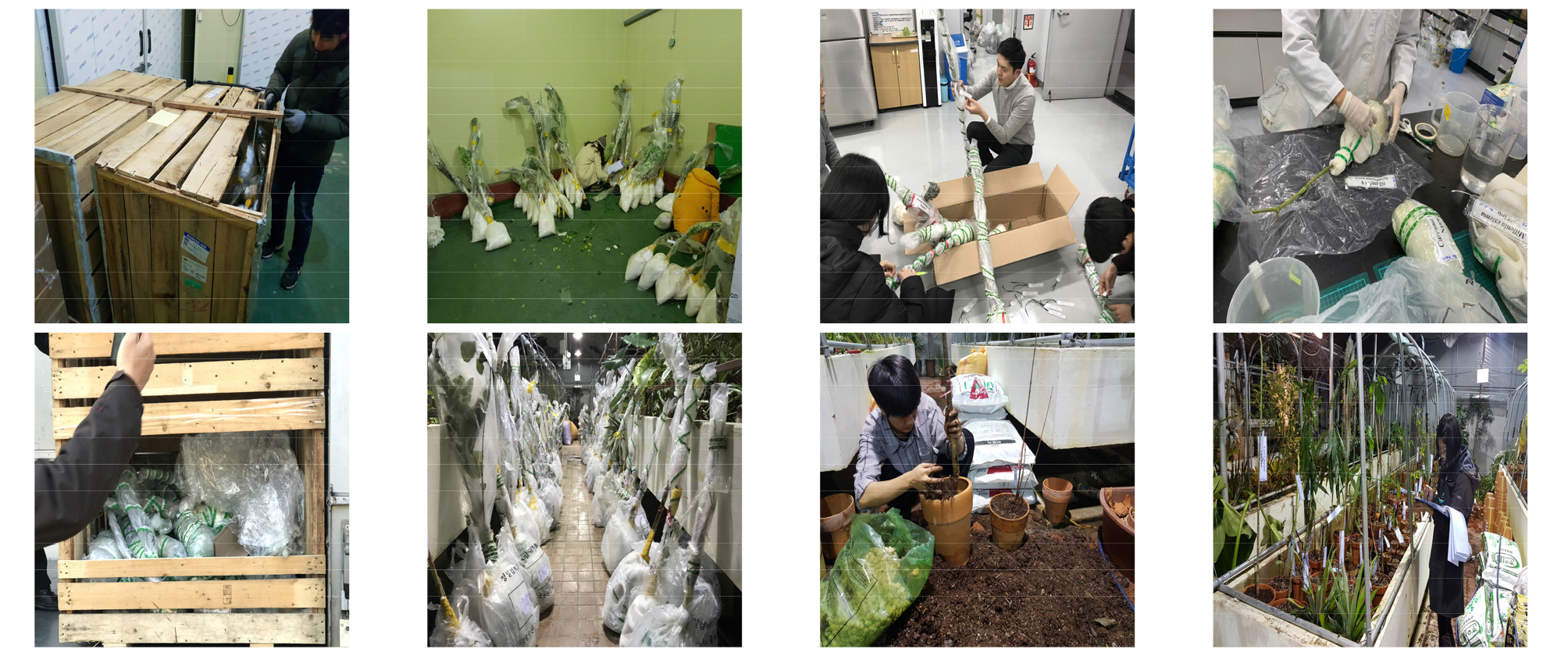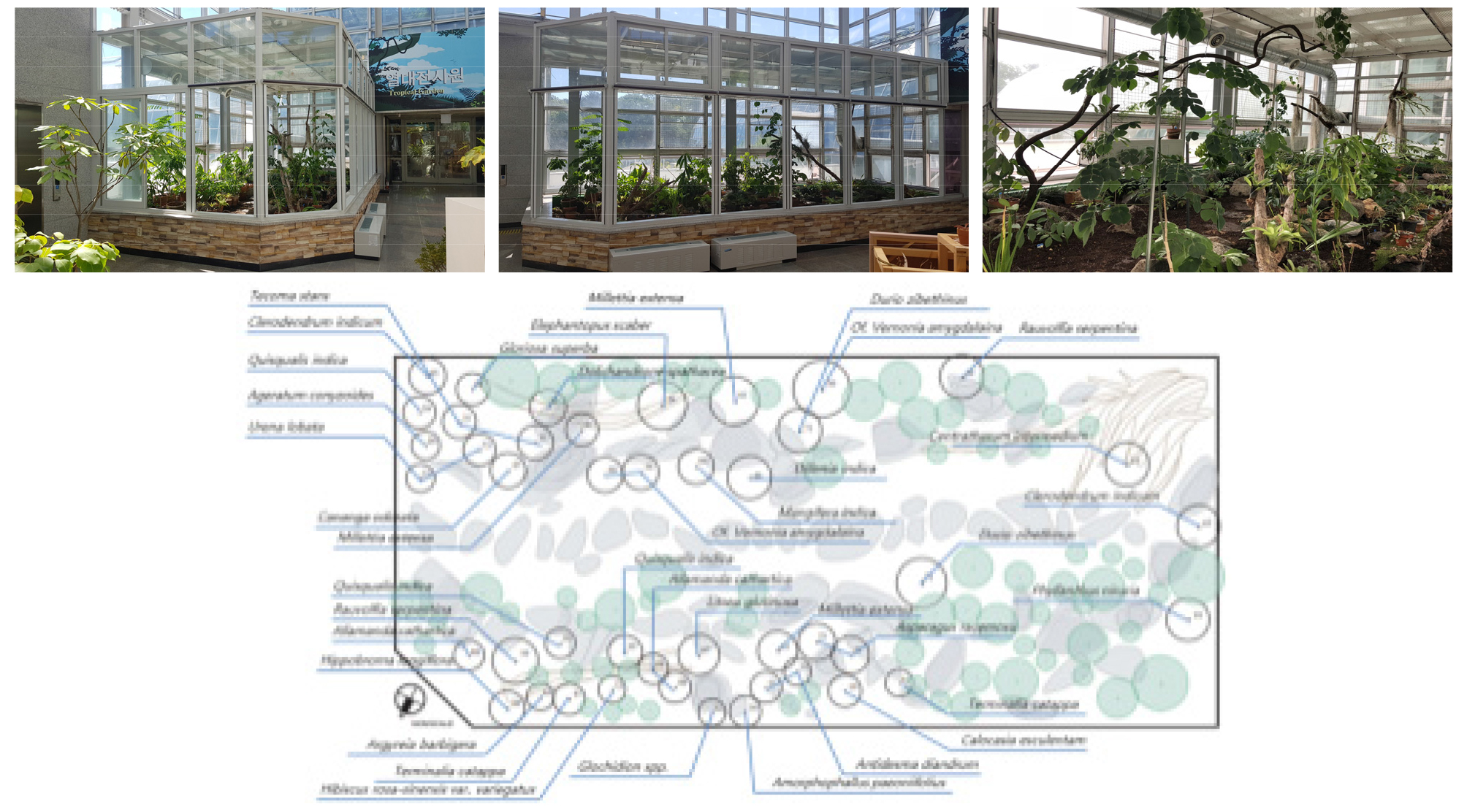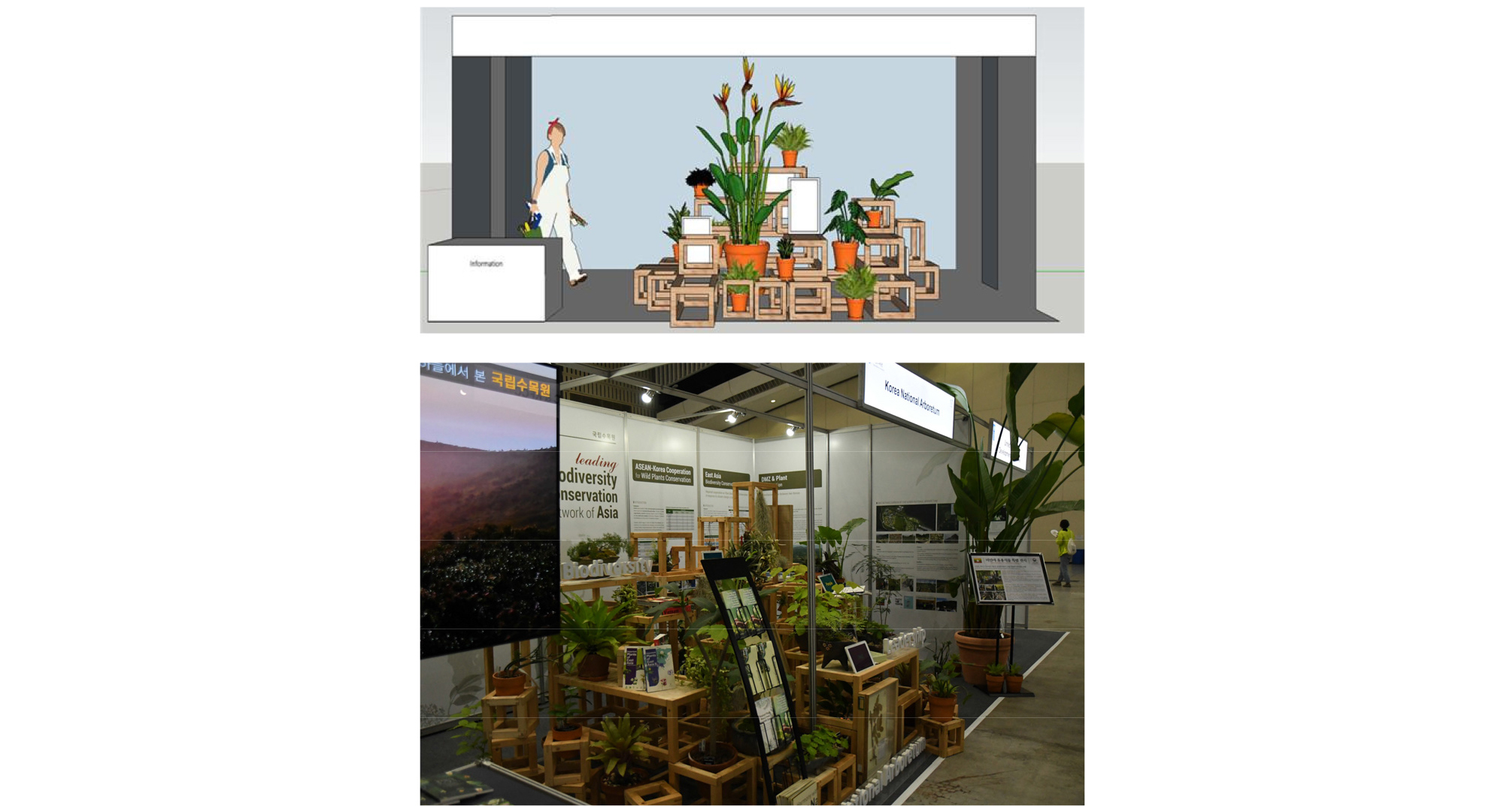서언
미얀마는 지형상 북부 산악지방, 서부 산악지방, 중부 저지대, 동부의 샨 고원 등 4개 주요 지역으로 나뉜다. 동부 고원지대는 중국, 라오스, 태국 및 말레이반도에 이르는 2,000 ㎞에 달하는 지역으로 국경무역이 가능한 구릉과 강으로 구성되어있으며 중부 평야 지대는 친드윈, 에야워디, 싯따웅 강 유역의 비옥한 평야 지대며 여카잉 산맥 서쪽 지역의 서부 산악지대, 동남아시아 최고봉인 카카보야지산이 있는 북부 산악지역 등으로 구분된다. 국토 대부분이 북회귀선 이남에 위치하고, 여름에 계절풍이 발달하는 벵골만에 면하여 계절풍 기후로 열대에 속한다. 원식생(原植生)은 상록 활엽수림 또는 건기에 낙엽이 지는 열대 우록림(雨綠林)이다. 북부의 카친 산지와 동부의 샨 고원은 고도가 높아서 온대에 속하며, 겨울에는 눈과 서리를 볼 수 있는 곳도 있다.
미얀마 Indo-Burma 지역은 13,500종의 식물 종이 분포하고 있는 생물 다양성 Hot spot이다. 북부 산악지역에서 남부의 맹그로브 지역에 이르는 다양한 특성의 생태계로 구성되어있다. 강우량이 2,000 ㎜가 넘는 지역에서는 상록 열대림이, 삼각주 지대에서는 무성한 홍수림 수목들이 자란다. 1,000-2,000 ㎜의 강우량을 보이는 지방에는 티크를 포함해 재질이 단단한 몬순림이 풍부하며 강우량이 1,000 ㎜ 미만인 지역에서는 삼림지들이 점차 관목지로 바뀐다. 산악지방에서는 해발 1,000 m의 강상(降霜) 한계선 위로 참나무와 소나무 숲이 발견된다. 하지만, 이러한 풍부한 생물 다양성은 인간에 의해 인위적인 간섭과 개발, 모노 크림 재배와 같은 지속적인 삼림 벌채로 위협받고 있다.
Kim et al. (2019)는 현재 기후온난화로 인하여 열대․아열대 작물이 국내에서 재배 가능한 환경으로 변화하고 있고, 웰빙・건강식품에 대한 국민들의 수요가 증가하고 있는 상황으로 외국 도입 작물의 국내 재배가 다양하게 이루어지고 있으며, 금후에도 더욱 빠른 속도로 확대될 것으로 전망하였다.
DeFilipps and Krupnick (2018)은 123과 472종의 미얀마 약용식물을 학명, 영명, 미얀마 식물명 그리고 미얀마 현지에서 쓰이고 있는 약용식물의 활용과 보존 상태를 종합적으로 정리했다. 이 중 약 13%가 보존 상태에 대한 평가를 받았으며, IUCN의 멸종 위기종 목록(IUCN, 2017)에 등재되었다. 비록, 전국에 다양한 식물과 생물 다양성이 분포되어 있지만, 미얀마는 여전히 지속 가능한 관리와 사용을 위한 인적 자원과 시설이 부족하다.
따라서 본 연구에서는 미얀마 열대 자생식물의 보전과 활용을 목적으로 도입하였고, 관상용 자원으로서의 활용 가능성 등에 대한 정보를 공유하고자 한다.
재료 및 방법
도입 목적
본 연구는 미얀마의 자원 가치가 높은 식물의 생체 수집을 통한 열대지역 유용・관상식물의 산업화 기반 구축과 국내에 정원 식물로써 활용 가치 연구를 위해 진행되었다. FAO (2015)에 따르면 미얀마는 2010년에서 2015년 사이에 매년 546,397 ㏊의 산림면적이 훼손되었으며, 이는 전체산림면적의 1.7%를 차지한다(Fig. 1). 미얀마는 세계에서 브라질, 인도네시아 다음으로 많은 산림면적 훼손을 보이며 이에 따른 생물자원의 보존 및 지속적인 이용에 대한 필요성과 중요성이 증대되지만, 아직 개인적인 역량이나 국가적인 역량의 부족으로 자국의 생물자원을 보존하고 지속적인 이용이 불가능한 상황이다.
미얀마는 산림 훼손을 방지하기 위하여 Permanent Forest Estate (PFE)를 지정하여 관리하기 시작하였으며, 약 12 백만 ㏊ (약 17.75% of land area)는 보전림(Reserved Forest), 4.7 백만 ㏊ (약 7.05% of land area)는 공공보호림 (Protected Public Fores)로 지정되어 있다. 2018년 5월까지 총 40개의 보호구역(Protected Area System)은 3.9 백만 ㏊ (약 5.79% of land area)로 지정되어 있으며, 미얀마 정부는 정책적으로 보전림과 공공보호림은 전체면적의 30%까지 보고구역은 10%까지 증가를 목적으로 하고 있다(Fig. 2).
미얀마의 경우 세계적으로 위협받는 평가의 경우 미얀마 식물 종의 겉씨식물과 일부 속씨식물에 한정된 매우 작은 부분만을 대상으로 수행되었다. 이에 43종이 세계적으로 위협받는 목록으로 세계자연보전연맹에 의해 2011년 지정되었다. 43종 대부분은 관목이며 그 중의 2/3가 Dipterocarpaceae 에 속해있다(Table 1). 식물목록 중 Cycas siamensis Miq., Calocedrus macrolepis Kurz, Cephalotaxus mannii Hook.f., Taiwania cryptomerioides Hayata 와 Picea farreri C.N.Page & Rushforth는 취약(Vulnerable) 종으로 평가받고 있다 (Table 1). 그 외에 약 29종이 정보부족(Data Deficient) 등급으로 되어 아직 미얀마 내 식물상에 관하여 종류와 분포, 군집 등의 기본적인 정보 부족이 생물 다양성을 보전하고 보호가 나가는 데 있어서 제한 요소로 작용하고 있다는 것을 알 수 있다(NBSAPs, 2015).
Table 1.
The IUCN Red List of threatened species
| Critically Endangered (CR) | Endangered (EN) | Vulnerable (VU) | Total | |
| Plant | 14 | 15 | 18 | 47 |
국립수목원은 2017년 미얀마 산림청(FD)과 미얀마 종 다양성 연구, 보전 및 생물 다양성 정보 분야에 대한 연구협력과 미얀마 자생식물 도입(생체) 및 전시의 목적으로 MOU를 체결하였다. 그리고 국립수목원은 MOU 후속 조치로 2018년 1월 미얀마 산림과학원(Forest Research Institute, FRI)과 공동조사한 수집식물 Albizia lebbek (L) Benth 등 102종을 1차로 도입하였다. 이는 미얀마에서 식물 생체를 국외로 반출한 첫 번째 사례이며, 국립수목원은 대량 식물 기증을 받은 두 번째 사례이다. 2차 식물 도입은 2018년 12월이며 Amorphophallus paeoniifolius (Dennst.) Nicolson. 등 123종 246개체이다. 미얀마 기증 식물 중 유실수 및 과실수로 포함된 Ananas comosus (L.) Merr 등 8종 16개체는 국립수목원 격리재배시설에서 관리 중이다. 하지만 겨울에 대부분 도입되었기 때문에 식물검역과 물품보관창고 등의 보관 기간이 길어지게 되면 식재 후 활착 등의 생육 문제가 발생하기 때문에 도입 시기 조율이 필요하다.
수집 방법
국립수목원 열대식물자원연구센터는 2013년 Shwe Set Taw Wildlife Sanctuary, 2014년 Shwe Set Taw Wildlife Sanctuary, 2015년 Kalaw Reserved Forest, 2016-2017년 Zalon Taung Reserved Forest 등 미얀마 자생식물 조사 및 수집을 미얀마 산림과학원과(Forest Research Institute, FRI) 공동으로 진행하고 수집한 식물은 미얀마 산림과학원 약용식물 전시원에 식재 및 관리되고 있다. 미얀마 산림과학원 내 약용식물 전시원은 1996년 설립되고 1999년 리모델링을 완료했다. Albizia lebbeck (L.) Benth. 등 약용식물 410종 수집 및 전시 중이며 세계 6대 질병(말라리아 및 열병, 고혈압 질환, 설사 및 이질 질환, 심장 질환, 당뇨병, 결핵 등)을 기초로 한 6개 전문 전시원을 보유하고 있다.
국립수목원 열대식물자원연구센터는 2017년 10월 미얀마 유용・관상식물 도입을 위해 반출 식물목록, 한국-미얀마 간 국제 운송 업체 선정, 미얀마 정부 행정처리 등을 협의하였다(Table 2). 미얀마 산림과학원은 2017년 10월까지 목록을 작성하고 12월까지 식물 반출을 위한 행정처리를 완료했으며 국립수목원으로 미얀마 식물을 1차(2018년 1월), 2차(2018년 12월)에 걸쳐 도입했다.
Table 2.
Administrative procedures between the National Arboretum and the Myanmar Forest Research Institute
미얀마 산림과학원은 외국으로 식물을 반출한 경험이 없어서 식물 포장작업을 위한 병해충 조사 및 화학적 방제 처리, T/R율 유지를 위한 가지 정리 등을 국립수목원 열대식물자원연구센터에서 미얀마 현지에서 교육을 진행하였다. 1) 국립수목원에 반출 식물 수량 파악 및 식물 포장 목록화 2) 식물에 대한 병해충 조사 및 화학적 방제 처리(깍지벌레, 응애류 등 처리를 위한 농약 사용 방법) 3) 식물이 국외에서 국내까지 이송하는 동안 식물의 상태를 유지하기 위한 T/R율 처리 및 분갈이 작업 4) 식물의 뿌리 부분 토양 제거 및 고사 방지를 위한 수분 유지 작업(솜, 이끼 등을 활용한 뿌리 부분 봉함) 5) 식물의 부피를 고려한 목 상자(열처리된 목재) 제작기반으로 교육 프로그램 및 실습을 하였다(Fig. 3).
항공 화물로 식물이 들어오면 농림축산검역본부(Animal and Plant Quarantine Agency) 인천공항 지역본부에 식물검역을 받을 수 있다. 농림축산검역본부는 수출입동물, 축산물 및 사료를 검역하고 수출입식물과 국내식물 검역을 담당하고 있다. 국제 항공편으로 도입된 미얀마 식물들 또한 농림축산검역본부 인천공항 지역본부에 검역을 거쳐야만 국내로 반입을 할 수 있다. 1) 수입식물 검역 신청 접수 2) 현장 검역(대량의 식물 수입 시 보관 창고에서 현장 검역) 3) 도입식물 확인 및 도입된 미얀마 식물과 미얀마 식물목록 대조 4) 실험실 검역(도입식물 병・해충, 잡초 분류 동정 및 격리재배 검역 관련) 5) 결과 확인 및 폐기, 반송(도입식물 반출 및 수입금지 식물 폐기, 격리재배 검역 식물 지정)의 검역 절차를 걸쳐 국립수목원 열대식물자원연구센터 순화 온실(증식 온실)에 재배 할 수 있다(Fig. 4). 격리재배 검역 선정된 미얀마 식물(유실수 및 과실수 Annona squamosa L. 등 16종 32개체)는 농림축산검역본부 서울지역본부에서 관리하며, 병해충 발생이 없을 시 1-2년 후 국립수목원 관리 수종이 될 수 있다(Fig. 5).
결과 및 고찰
식물 도입 및 활용
국립수목원은 열대식물자원연구센터는 2014년부터 미얀마 산림청(FD), 라오스 농림연구원(National Agriculture and Forestry Research Institute of Laos), 베트남 생태생물자원연구소(Institute Ecology and Biological Resource)과 협업으로 현지 자생식물 조사 및 수집연구를 통해 확보한 식물 생체, 표본 전시로 열대 우림 식물의 중요성과 국립수목원과의 공동연구 성과를 홍보하였다. 3 개국 중 식물 생체가 국립수목원으로 도입된 건 미얀마가 처음으로 국립수목원은 Amorphophallus paeoniifolius (Dennst.) Nicolson 등 225종 중 일부를 열대식물자원연구센터(TPRRC) 미얀마 전시관(Fig. 6)을 18년 9월경 조성하였다.
2019 아태지역 산림주간(Asia-Pacific Forestry Week)은 유엔식량농업기구 (FAO)의 아시아-태평양 사무국에서 4년마다 주최하는 행사로, 아태지역 46개국 회원국 정보, 국제기구, 학회, NGO 등이 참여하는 국제행사 동안 홍보부스를 설치하여 동남아시아 지역 특히 미얀마 국가의 국제협력 및 연구 성과를 홍보하였다(Fig. 7).
도입수종 중 집중 모니터링 중인 Amorphophallus paeoniifolius (Dennst.) Nicolson은 2019년 5월 잎의 생장 주기가 시작되었다. 2018년 12월 미얀마에서 생체(덩이줄기) 형태로 도입되었다. 화분에 식재 후 약 5개월이 지난 시점에서 잎의 생장 주기가 시작되었으며, 2019년 7월 29일 기준으로 높이 80 ㎝, 너비 60 ㎝의 크기로 성장하였다. 생육환경에 따라 3-5개월 뒤 잎이 지고 나면 다시 덩이줄기로 되돌아가거나 지금의 모습을 유지할 것으로 추측된다. 지금까지 이 식물에 알려진 정보는 온실 즉 인공 환경에서의 연구가 아닌 실외에서의 연구 결과이기 때문에 전문적인 온실에서 자란 Amorphophallus paeoniifolius (Dennst.) Nicolson (Nedunchezhiyan et al., 2011)은 잎의 주기가 더 오래 갈 수도 있으며, 꽃의 주기 또한 느리거나 빠를 수 있을 것 같다는 추측을 할 수 있다. 잎이 자라는 동안 이식을 할 때 잎자루가 꺾이면 더는 성장 하지 않는다. 하지만 잎꽂이 할 수 있어서 소엽 부분을 잘라 흙에 꽂으면 30일 이내로 뿌리를 내린다. 또한, 잎의 생장 주기에 잎자루가 낮과 밤의 방향을 달리 하여 자라는 볼 수 있었으며, 인공 환경 생육 조건에서의 잎의 생장 주기, 꽃의 생장 주기의 생활사를 모니터링하고 실내에서 키울 수 있는 적정 생육환경을 위한 연구가 필요하다.
도입식물의 자원분류
미얀마 산림과학원으로부터 도입한 식물 종 65과 326종 중 현재까지 미얀마에서 약용으로 사용 중이거나 최근까지 질병을 예방하거나 치료를 목적으로 연구된 기록이 있는 식물을 조사하였을 때 59과 146종으로 나타났다. 식물 전체를 약용으로 쓰는 식물로 Andrographis paniculata (Burm.f.) Nees 등 36종이 있었으며, 잎은 Barleria prionitis L. 등 87종, 수피와 수지 등 식물의 줄기를 이용하는 식물은 Sandoricum indicum Cav. 등 55종, 열매는 Anacardium occidentale L. 등 29종, 종자는 Areca catechu L. 등 27종, 꽃은 Holarrhena pubescens Wall. ex G.Don 등 25종이 이용되고 있다. 잎과 함께 사용되는 부위로는 뿌리, 꽃, 수피, 열매 순으로 나타났으며, 오일을 사용하는 식물로는 Plumeria alba L. 등 9종으로 잎 또는 꽃을 함께 사용했다. 해열에 효과가 있는 식물로는 Andrographis paniculata (Burm.f.) Nees 등 35종, 백반증(白皮症), 백선(白癬) 등 피부질환에 효과가 있는 식물로 Anacardium occidentale L. 등 33종이 있으며, 이외에도 설사, 변비, 이질, 부종, 위장질환, 신장질환 등에 효과가 있는 것으로 조사되었다(Table 3).
Table 3.
Medicinal plants in Myanmar and indications
| Family Name | Scientific Name | (Usage parts) Indications |
| Acanthaceae | Andrographis paniculata |
(Whole plant) fever, neutralize poison, (Leaf, Root) febrifuge, stomachic, tonic, anthelmintic |
| Barleria prionitis |
(Leaf) dropsy, febrifuge, coughs, fever, bronchitis, (Root) swellings, bumps, sores | |
| Acoraceae | Acorus calamus | (Root) fever, coughs, sore muscles |
| Agavaceae | Ananas comosus | (Leaf) antioxidant, antibacterial, antidiabetic |
| Aloaceae | Aloe vera | (Leaf) boils, edema, liver diseases, skin diseases, fevers, asthma, leprosy |
| Amaryllidaceae | Eurycles amboinensis | (Leaf) swellings, rheumatism, aches, cathartic |
| Anacardiaceae | Anacardium occidentale |
(Bark) restorative (Bark, Leaf, Fruit) anthelmintic, leucoderma, skin diseases (Fruit) pain reliever |
| Lannea coromandelica | (Bark, Leaf) inflammatory, digestive problems | |
| Mangifera indica |
(Bark) astringent (Fruit) laxative, rind, tonic (Seed) anti asthmatic | |
| Spondias pinnata |
(Bark) dysentery (Fruit) antiscorbutic, dyspepsia | |
| Annonaceae | Annona squamosa | (Whole plant) vascular, respiratory, digestive, excretory functioning, fever |
| Cananga odorata |
(Whole plant) antibacterial, antifungal, cytotoxicity, malaria, gout, headache (Flower) ophthalmia | |
| Apocyaceae | Allamanda cathartica |
(Bark) Hydragoguein ascites (Leaf) cathartic |
| Catharanthus roseus |
(Whole plant) diabetes (Leaf) menorrhagia, wasp stings (Root) leukemia, anti-cancerous | |
| Holarrhena pubescens |
(Bark) stop bleeding, fever, stomach, earaches (Leaf) muscle pains, dysentery, cholera (Root) stomach (Fruit) ringworm (Flower) flatulence, phlegm, bile, leprosy, infections | |
| Nerium oleander |
(Leaf) ringworm, itchy skin, external inflammations, alternatively, snake venom (Root) scorpion, snakebites, skin cancer, fungal conditions earache, inflected lesions, leprosy | |
| Plumeria alba | (Leaf, Flower, Oil) Anti-inflammatory, rheumatism | |
| Plumeria obtuse | (Leaf) antibacterial | |
| Plumeria rubra |
(Whole plant) digestive, excretory, respiratory, leprosy, infections, stomach ailments (Sap) laxative, stomachache, bloating (Flower) asthma (Leaf, Flower) gas, phlegm (Bark, Leaf) laxative, gonorrhoea, venereal sores | |
| Rauvolfia serpentina |
(Leaf) eye conditions (Root) palpitations, hypertension, aggression, restlessness, excitability, vomiting (Leaf, Root) sedative | |
| Strophanthus wallichii | diabetic, cancer, tuberculosis | |
| Thevetia peruviana. |
(Bark) fevers, burns, ringworm, rashes (Bark, Seed) purgative, heart tonic (Leaf) aches (Leaf, Flower) rashes, skin disorders (Root) ringworm infections | |
| Araceae | Amorphophallus paeoniifolius | (Tuber) sagging belly in women, enlargement of the bladder |
| Arecaceae | Areca catechu |
(Seed) anaemia, fits, leucoderma, leprosy, obesity, worms, dysentery, malaria (Fruit) astringent, stimulant (Fruit, Leaf) laxative, bloating, oedema |
| Aristolochiaceae | Aristolochia indica |
(Whole plant) throat blisters, canker sores (Leaf) edema, couth (Leaf, Root) poisoning, coughs, heart disease, blood irregularities, dizziness (Root) snake, scorpion venoms, fever |
| Asclepiadaceae | Dregea volubilis |
(Whole plant) sore throat, gonorrhoea, asthma (Leaf) sores, swelling, drain pus (Root) rabies |
| Asparagaceae | Asparagusracemosus Willd. | (Root) antioxidant, female reproductive health disorders |
| Sansevieriacylindrica Bojer | (Leaf) demonstrated inhibition of the capillary permeability activity | |
| Asteraceae | Ageratum conyzoides | (Leaf) skin diseases, leprosy |
| Eclipta alba | (Whole plant) Phytochemistry, neuropharmacological activities, microbial diseases | |
| Of. Vernonia amygdalaina | (Leaf) antioxidant, anti-diabetic activities | |
| Bignoniaceae | Dolichandrone spathacea | (Leaf, Bark) cancer |
| Kalanchoe laciniata | (Whole plant) antioxidant, antibacterial and gut problems | |
| Millingtonia hortensis |
(Leaf) menstruation, hypertension (Flower, Shoot) hypertension, heart palpitations (Root) dizziness, sore eyes, gas disorders, vitiligo, alcoholic intoxication | |
| Tecoma stans |
(Bark) anti syphilitic, alcohol poisoning (Leaf) hypoglycemic properties | |
| Bombacaceae | Bombax ceiba |
(Bark) Astringent, diuretic (Leaf, Flower) diabetes (Root) Astringent, diuretic, tonics |
| Caesalpiniaceae | Bauhinia purpurea |
(Bark) Astringent (Flower) Employed as a laxative |
| Senna siamea | (Leaf, Flower, Fruit) tonic, stomach | |
| Caricaceae | Carica papaya |
(Leaf) muscle stiffness, aches, menstruation (Fruit) phlegm, hear, cleanses the bloods, bile, gallstones, liver, hemorrhoids, itching, rashes, ringworm, skin problems, sores, venereal disease (Seed) deworming |
| Colchicaceae | Gloriosa superba |
(Leaf) dysentery (Seed) deworming, diarrhea |
| Combretaceae | Combretum pilosum | (Fruit) anthelmintic, ringworm |
| Terminalia bellerica | (Whole plant) edema, abdominal swelling, leprosy, headaches, stiff neck, and dizziness | |
| Terminalia catappa | (Whole plant) astringent, dysentery | |
| Terminalia chebula |
(Fruit) astringent, anti dysenteric, laxative, tonic (Seed) pimples (Leaf) laxative, arminatives, blood fortifying preparations (Bark) diarrhea, dysentery | |
| Quisqualis indica |
(Leaf) dysentery (Seed) deworming, diarrhea | |
| Commelinaceae | Tradescantia spathacea |
(Whole plant) coughs (Stem, Leaf) vomiting of blood (Leaf) burns, scalds, dysentery |
| Costaceae | Costus speciosus | (Stem) laxative |
| Dilleniaceae | Dillenia indica | (Fruit) phlegm, fevers, chest pains, fatigue |
| Dracaenaceae | Sansevieria zeylanica |
(Whole plant) remedy for heat of blood, gonorrhoea, heart disease, itch, leprosy, fever, rheumatism, glandular enlargements, other ailments (Root) cough, tuberculosis (Root, Leaf) snake bite |
| Ebenaceae | Diospyros burmanica | (Wood) against Leishmania |
| Euphorbiaceae | Emblica officinalis |
(Whole plant) laxative (Bark, Root) astringent (Leaf) diarrhea, scalded skin (Fruit) coughs, asthma, bronchitis |
| Euphorbia tirucalli |
(Root, Bud) laxative, couth, pectoral pain (Root, Stem) haemorrhoids, swellings (Root) schistosomiasis, gonorrhoea, snakebite (Root, Oil) stomachache | |
| Jatropha multifida |
(Whole plant) granulation, fracture, skin ulcerations, wounds (Leaf) scabies (Seed) emetic, purgative | |
| Pedilanthus tithymaloides |
(Whole plant) Inhibits HSV Infection (Leaf) wound | |
| Phyllanthus urinaria |
(Whole plant) diuretic, diarrhea, diabetes, tonic, fevers, malaria, ulcers, sores, tumors (Leaf) convulsions, colic, constipation, urethral discharges, hiccup, cough | |
| Fabaceae | Abrus precatorius |
(Whole plant) poisonous (Leaf) sore throat (Seed) emetic, purgative, ashes (Root) expectorant, headaches, hemorrhoids |
| Acacia catechu |
(Whole plant) febrifuge, sialagogue, stimulant, styptic, antiphlogistic, astringent, corrective, and expectorant | |
| Acacia farnesiana |
(Bark) toothaches, inflammation, infections, diarrhea (Leaf) gonorrhoea | |
| Albizia lebbeck |
(Bark) diarrhea, dysentery (Flower) carbuncles, swellings (Seed) diarrhea, gonorrhoea | |
| Bauhinia acuminata |
(Flower) laxative (Root) cold, cough, sore throat, cataplasm, ulcers | |
| Butea monosperma |
(Bark) strength, longevity (Sap) sores, rashes, bumps, diarrhea Gum, Leaf) astringent (Leaf) tonics (Flower) anal pain, nosebleeds, infections, leprosy (Seed) laxative (Seed, Bark) neutralizing snake venom | |
| Cassia alata |
(Leaf) vitality, eczema (Flower) skin diseases (Root) ringworm (Seed) itching, couth, asthma, ringworm, skin disorders, urination, leprosy | |
| Caesalpinia sappan |
(Whole plant) dysentery and diarrhea, skin ailments, vomiting, inflammation (Seed) sedative | |
| Cassia fistula |
(Whole plant) ringworm, scabies, skin disorders (Leaf) laxative, constipation, leprosy and other skin diseases (Fruit) laxative, leprosy, phlegm (Root) purgative, flatulence | |
| Cassia glauca | (Leaf) urination, gonorrhoea, fevers, diabetes, stool, dysentery, illnesses | |
| Cassia tora | (Leaf) laxative, vermifuge, skin diseases, eczema, indigestion, vermicide, ringworm | |
| Clitoria ternatea |
(Whole plant) neutralizes snake venom (Leaf) infection (Root) edema, vitiligo, cataracts (Flower) infantile diseases (Fruit) headaches (Seed) testes, hiccups | |
| Fabaceae | Delonix regia |
(Bark) febrifuge (Leaf) contain Saponin and alkaloid |
| Erythrina suberosa (Mohanta et al., 2017) | (Leaf) antimicrobial, antioxidant | |
| Millettia extensa (Raksat et al., 2018) | (Stem) antibacterial | |
| Pongamia pinnata |
(Seed, Oil) stomachic, cholagogue, dyspepsia (Seed) cough, febrifuge, tonic (Leaf) rheumatism, skin diseases, hemorrhoids, itches (Flower) diabetic (Bark) relieve bleeding hemorrhoids (Root) clean teeth | |
| Tadehagi triquetrum |
(Whole plant) kill worms (Root) urine (Leaf) dysentery, bloated stomach, indigestion, bleeding hemorrhoids (Oil) scabies, impetigo, erysipelas, sores, seborrhoeic, dermatitis, fever, dandruff, itching, head lice | |
| Tamarindus indica |
(Root) gonorrhoea, hemorrhoids, jaundice, stomach (Bark) vomiting, gastic problems, sores, bites (Leaf) earaches, snake venom (Fruit) laxative, tonics (Seed) skin discarded, diarrhea, dysentery | |
| Xyliaxylo carpa |
(Bark) astringent (Seed, Oil) rheumatism | |
| Hyperiaceae | Calophyllum amoenum | (Flower) rheumatoid arthritis, head ache and burning sensation, blood tonic |
| Calophyllum inophyllum |
(Bark) constipation, hemorrhaging (Sap) wounds, sores (Seed) aches, pains, gonorrhoea, leprosy, skin disease | |
| Calotropis procera |
(Root) snake, scorpion venom, skin diseases, leprosy, epileptic fits (Flower) cholera (latex) face discolorations (Stem) internal hemorrhoids (Leaf) earaches, stomach, phlegm, asthma | |
| Mesua ferrea |
(Whole plant) digestion, blood disorders, edema, neutralize poisoning, alleviate heart, bladder pains (Leaf) snakebites (Bark, Root) tonics (Flower) astringent | |
| Lamiaceae | Clerodendrum indicum |
(Regin) rheumatism (Leaf) fevers, respiratory, coughs (Leaf, Root) leprosy, female disorders, asthma, fever (Seed) lung infections, male disorders, gonorrhoea, asthma, bronchitis, aches |
| Coleus aromaticus (Choudhary, 2009) |
(Leaf, Root) wound healing activity (Leaf) diuretic | |
| Ocimum sanctum | anto-stress, blocking CRHR1 receptor, and inhibiting 11β-HSD1 and COMT activities | |
| Ocimum gratissimum (Chao et al., 2017) | (Whole plant) controlling body weight of menopausal women | |
| Lauraceae | Cinnamomum macrocarpum |
(Bark) coughs, diarrhoea, dysentery (Root, Bark, Leaf) rheumatism |
| Litsea glutinosa (Bhowmick et al., 2014) | (Leaf) analgesic, antipyretic, and anti-inflammatory | |
| Leeaceae | Leea aequata (Tun et al., 2019) | (Whole plant) wounds and skin diseases |
| Leea macrophylla | (Root) guinea worm, ringworm, dysentery, neuralgia, and splenitis | |
| Lythraceae | Lagerstroemia speciosa |
(Bark, Leaf) purgative (Leaf) diabetes (Seed) narcotic (Root) astringent |
| Malvaceae | Durio zibethinus (Aziz et al., 2019) |
(Fruit) beneficially reduces blood glucose and cholesterol levels, anti proliferative and probiotics effects |
| Urena lobata |
(Bark) virility, sperm (twig) toothaches (Leaf) edema (Leaf, Root) diuretic, expectorant, phlegm, fever, sores, bile, venereal, alleviate leprosy, skin diseases | |
| Meliaceae | Azadirachta indica |
(Gum) tonic (Bark) tonic, fever, toothaches (Flower) stomachic, dizziness (Fruit) urinary infections |
| Chukrasia velutina |
(Bark) diarrhoea, febrifuge (Leaf) malaria | |
| Sandoricum indicum (Tanaka et al., 2001) | (Stem, Bark) inhibiting activity against several tumor cell, lymphocyte proliferation | |
| Menispermaceae | Tinospora cordifolia |
(Whole plant) fever, sores, urinary disorders, neutralize poisons, menstrual disorders, earaches, phlegm balances (Stem, Leaf) stomachic, cholagogue (Leaf) earaches, prevent illnesses |
| Mimosaceae | Mimosa pudica |
(Whole plant) phlegm, bile, edema (Leaf) hemorrhoids (Root) sores |
| Acacia concinna |
(Leaf) diarrhea, malaria, constipation, bloating (Flower) phlegm (Fruit) alleviate gastric disease, stomachaches (Leaf, Fruit) skin problem, snake venom, vomiting | |
| Leucaena glauca |
(Whole plant) antidotes for poisons (Bark) aches (Leaf) gas and neutralize poison, aches, male disorders(Seed) ache, edema (Root, Bark) miscarriages | |
| Samanea saman |
(Bark, Leaf) diarrhoea (Bark) stomach-ache, laxative, skin problems, dermatitis, eczema, pruritus | |
| Moraceae | Artocarpus heterophyllus |
(Bark, Sap) ulcers, abscesses (Seed) indigestion (Root) diarrhea, fever |
| Moringaceae | Embelia ribes | (Root) fever, diuretic |
| Moringa oleifera | (Leaf) heart disease | |
| Myrtaceae | Eugenia operculata | (Leaf, Oil) burn wound |
| Psidium guajava | (Leaf, Fruit) diabetes | |
| Nyctaginaceae | Mirabilis jalapa |
(Root) aphrodisiac, diuretic, purgative, diarrhoea, indigestion, fever (Leaf) diuretic, inflammation, abscesses |
| Oleaceae | Linociera macrophylla | (Root) uterus infection |
| Jasminum sambac |
(Leaf, Flower) astringent, febrifuge, galactofuge, fever, asthma (Root) fevers, venereal diseases, bronchitis, asthma | |
| Jasminum auriculatum |
(Leaf) mouth ulcers (Flower) consumption(Tuberculosis) | |
| Pandanaceae | Pandanus odoratissimus |
(Root) skin diseases, ulcers, dyspepsia, diabetes, fever, leprosy (Leaf) cardiotonic, purgative, leprosy, smallpox, scabies, heart and brain diseases (Oil) antispasmodic, headache, rheumatism |
| Piperaceae | Piper betel |
(Leaf) phlegm, controlling flatulence, promoting vitality, virility, neutralizing, poison, supporting heart, bowel functions, curing coughs, heart diseases |
| Piper longum |
(Fruit) digestive, stiff neck, malaria, ague, influenza, toothaches (Root) backaches, aid digestion (Leaf, Fruit) gonorrhoea | |
| Piper nigrum |
(Fruit) digestive (Seed) phlegm, gas, coughs, asthma, bronchitis, diarrhea | |
| Poaceae | Cymbopogon citratus (Basera et al., 2019) |
(Whole plant) ease pain, inflammation, endemic (Stem) fever, malaria |
| Cyperus scariosus |
(Root) phlegm, bile, fever, bowel problems, asthma, snake venom, nausea, gastric ailments, our stomach, swollen limbs, itching, leprosy, herpes, scabies | |
| Pontederiaceae | Eichhornia crassipes | (Leaf) diarrhoea, fevers |
| Portulacaceae | Talinum paniculatum | (Root) surrogate aphrodisiac |
| Talinum portulacifolium |
(Whole plant) aphrodisiac properties (Leaf) eye diseases (Root) cough, gonorrhoea | |
| Primulaceae | Ardisia humilis |
(Whole plant) menstrual disorders (Leaf) carminative, stimulant |
| Rhamnaceae | Ziziphus jujuba |
(Bark) diarrhea (Leaf) scorpion venoms (Leaf, Fruit) laxative, blood purifier (Fruit) pectoral (Root) fever |
| Rhizophoraceae | Carallia brachiata |
(Bark) eye infections, blood fortifying preparations, fever reducing remedies, itching (Fruit) infected wounds |
| Rubiaceae | Hymenodictyon orixense | (Bark) febrifuge, tonic, skin diseases, antiperiodic effects, headache |
| Ixora coccinea |
(Root) appetizer, stomachic, dysentery, sores (Flower) dysentery, leukorrhea, catarrhal bronchitis | |
| Morinda angustifolia |
(Leaf) gas, stomachaches, bile, heart disease, hemorrhaging of blood, diabetes (Fruit) asthma, coughs, indigestion, hypertension | |
| Morinda tinctoria |
(Leaf) diabetes, stomach ulcers, prevents cancer, fragile bones, thyroid gland function, regulates the liver and pancreatic function, removes constipation. | |
| Rutaceae | Aegle marmelos |
(Fruit) indigestion, fevers (Leaf) diarrhea, bronchitis, coughs, edemas |
| Citrus medica |
(Whole plant) asthma, arthritis, headache, stomach-ache, intestinal parasites, certain psychological disturbances (Fruit) malaria, coughs (Stem) febrifuge pills | |
| Hesperethusa crenulata (Wangthong et al., 2010) |
(Stem, Bark) skin conditions, anti-inflammatory, significant antioxidant, mild tyrosinase inhibition and slight antibacterial activities | |
| Santalaceae | Santalum album |
(Oil) itching (Wood) gonorrhoea, fever, hot water burns, aches, diarrhea |
| Sapindceae | Cardiospermum halicacabum |
(Whole plant) rheumatism, fever, tumors, heart disease, ailments, edema, aches, throat problems (Shoot, Leaf) diuretic (Leaf) rheumatism, embrocation, skin disorders, ringworm, irregularities (Root) laxative, diuretic, emetic, purgative, diaphoretic |
| Sapotaceae | Madhuca latifolia (Chandra and Keshavkant, 2018) | (Seed) lipid oxidation, lipase |
| Mimusops elengi |
(Bark) thrush (Bark, Flower, Fruit) heart problems (Flower) dental diseases, cought, heat rashes, prickly heat (Fruit, Seed) diarrhea | |
| Scrophulariceae | Scoparia dulcis |
(Whole plant) toothaches, blood in urine (Leaf) fevers, nausea (Root) menstruation, gonorrhoea, dizzy spells, toothaches |
| Sterculiaceae | Mansonia gagei | (Wood, Root) phlegm, hearts diseases, urinary disorders, anemia, itches |
| Sterculia foetida |
(Bark) aperient, diaphoretic, diuretic, dropsy, rheumatism (Leaf) aperient (Fruit) astringent, mucilaginous, gonorrhoea (Seed) purgative in ghana (Oil) laxative, carminative | |
| Verbenaceae | Clerodendrum serratum (Patel et al., 2014) | (Root) allergic, hepatoprotective activity, anti-oxidant, anti-inflammatory and anticancer |
| Vitex negundo | (Fruit) sedative | |
| Vitex trifolia |
(Leaf) skin infections, spleen, rheumatism, fevers, neutralize poisons, ear infection (Leaf, Flower) febrifuge, emetic (Root) ingesting, inhaling, fever | |
| Vitex quinata | (Bark) tonic, stomachic | |
| Zingiberaceae | Alpinia conchigera | (Leaf) rheumatism, ringworm |
| Alpinia officinarum | (Stem) urination | |
| Curcuma aromatica |
(Leaf) nosebleeds, internal haemorrhage, painful menstruation, shock, chest pains associated with low liver energy, angina, cancer | |
| Hedychium coronarium |
(Seed) aromatic, carminative, stomachic (Root) febrifuge, anthelmintic indications (Leaf) stiff, sores | |
| Kaempferia galanga | (Root) dyspepsia, headaches, sore throats, coughs | |
| Kaempferia rotunda |
(Whole plant) age-dependent diseases such as myocardial infarction, diabetes, atherosclerosis, cancer | |
| Kaempferia spp. | (Stem) dysentery | |
| Zingiber officinale |
(Stem) colds, runny noses, coughs, asthma, bronchitis (Leaf) influenza, digestive aid, blood purifier | |
| Zingiber zerumbet | (Stem) carminative |
적요
생물 다양성을 유지하고 기후 변화를 조절하는 데에 중심적인 역할을 하는 열대림에는 식품 또는 의약품 개발 등 산업적으로 이용 가능한 자원 식물이 풍부하다. 이들을 활용하기 위하여 열대 및 아열대 식물의 보존 및 증식에 관한 연구가 필요한데, 국내에서는 이에 관한 연구가 미비한 실정이다. 본 연구는 국립수목원 열대식물자원연구센터가 2013년부터 미얀마 천연자원환경보전부(Ministry Of Natural Resources and Environmental Conservation)와 미얀마 산림과학원(Forest Research Institute)과 함께 미얀마 보호지역 및 Sagging 지역 내 식물 다양성 보존을 위한 공동 현장 조사, 연구 및 출판 등의 협력사업을 진행하고 있는 정보를 제공하고자 한다. 국립수목원과 미얀마 산림과학원 공동연구의 성과로 2018년 12월 미얀마 산림과학원으로부터 미얀마 유용 및 관상식물 65과 326종의 식물 생체 및 표본 등을 기증받아 국립수목원 열대식물자원연구센터에 보존과 교육 목적으로 전시 중이다. 이 기증은 미얀마에서 식물 생체를 국외로 반출한 첫 번째 사례이며, 국립수목원은 2008년 독일에서 열대식물을 기증받은 사례 다음으로 두 번째로 외국 정부의 공식적인 대량 식물 도입 사례다. 도입한 식물 중 Santalum album L.은 IUCN Red List of Threatened Species (IUCN, 2017)에 취약종으로 분류되어 있다. 본 연구 결과를 토대로 열대 및 아열대 식물의 생육에 적합한 인공 환경을 구명하고 국내의 실내 정원소재 및 미세먼지, 공기정화 능력을 가진 열대식물의 발굴하고 추후 열대 및 아열대 식물의 보존 및 증식 방법과 더 나아가 생물 다양성 보존 및 산업적 이용을 위한 연구에 박차를 가할 수 있을 것이다.



